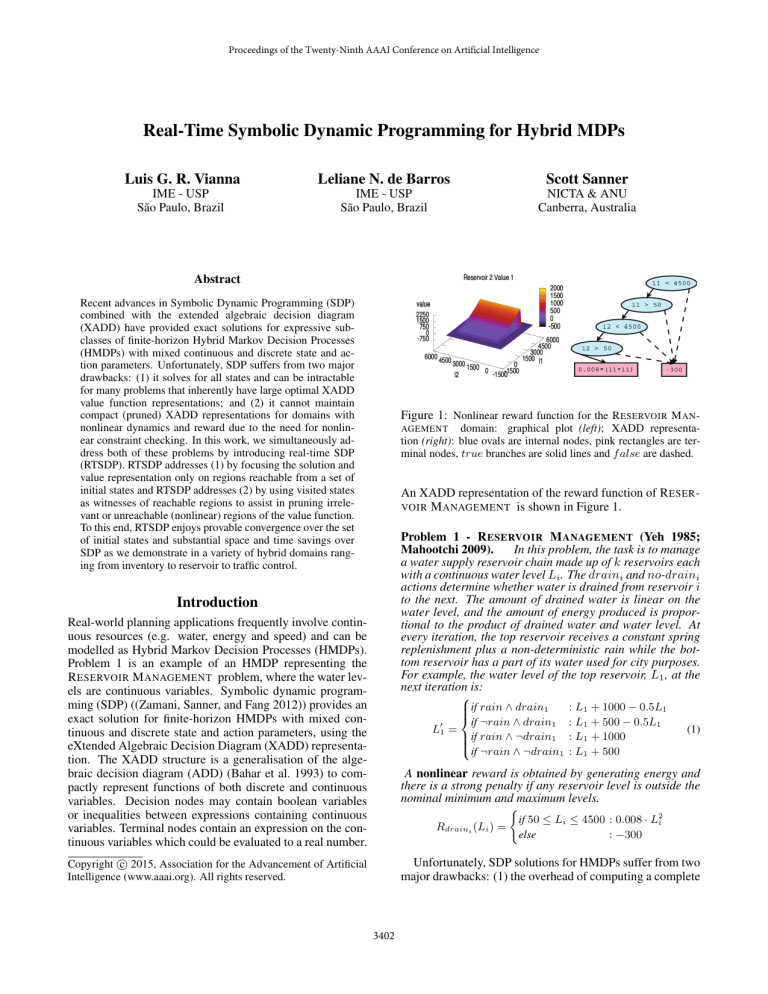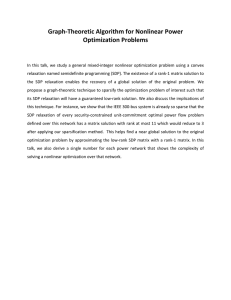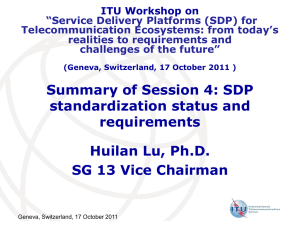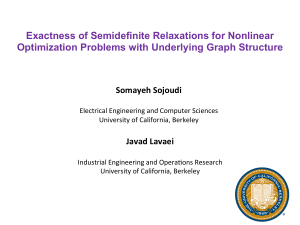
Proceedings of the Twenty-Ninth AAAI Conference on Artificial Intelligence
Real-Time Symbolic Dynamic Programming for Hybrid MDPs
Luis G. R. Vianna
Leliane N. de Barros
Scott Sanner
IME - USP
São Paulo, Brazil
IME - USP
São Paulo, Brazil
NICTA & ANU
Canberra, Australia
Abstract
Recent advances in Symbolic Dynamic Programming (SDP)
combined with the extended algebraic decision diagram
(XADD) have provided exact solutions for expressive subclasses of finite-horizon Hybrid Markov Decision Processes
(HMDPs) with mixed continuous and discrete state and action parameters. Unfortunately, SDP suffers from two major
drawbacks: (1) it solves for all states and can be intractable
for many problems that inherently have large optimal XADD
value function representations; and (2) it cannot maintain
compact (pruned) XADD representations for domains with
nonlinear dynamics and reward due to the need for nonlinear constraint checking. In this work, we simultaneously address both of these problems by introducing real-time SDP
(RTSDP). RTSDP addresses (1) by focusing the solution and
value representation only on regions reachable from a set of
initial states and RTSDP addresses (2) by using visited states
as witnesses of reachable regions to assist in pruning irrelevant or unreachable (nonlinear) regions of the value function.
To this end, RTSDP enjoys provable convergence over the set
of initial states and substantial space and time savings over
SDP as we demonstrate in a variety of hybrid domains ranging from inventory to reservoir to traffic control.
Figure 1: Nonlinear reward function for the R ESERVOIR M AN AGEMENT domain: graphical plot (left); XADD representation (right): blue ovals are internal nodes, pink rectangles are terminal nodes, true branches are solid lines and f alse are dashed.
An XADD representation of the reward function of R ESER VOIR M ANAGEMENT is shown in Figure 1.
Problem 1 - R ESERVOIR M ANAGEMENT (Yeh 1985;
Mahootchi 2009).
In this problem, the task is to manage
a water supply reservoir chain made up of k reservoirs each
with a continuous water level Li . The draini and no-draini
actions determine whether water is drained from reservoir i
to the next. The amount of drained water is linear on the
water level, and the amount of energy produced is proportional to the product of drained water and water level. At
every iteration, the top reservoir receives a constant spring
replenishment plus a non-deterministic rain while the bottom reservoir has a part of its water used for city purposes.
For example, the water level of the top reservoir, L1 , at the
next iteration is:
Introduction
Real-world planning applications frequently involve continuous resources (e.g. water, energy and speed) and can be
modelled as Hybrid Markov Decision Processes (HMDPs).
Problem 1 is an example of an HMDP representing the
R ESERVOIR M ANAGEMENT problem, where the water levels are continuous variables. Symbolic dynamic programming (SDP) ((Zamani, Sanner, and Fang 2012)) provides an
exact solution for finite-horizon HMDPs with mixed continuous and discrete state and action parameters, using the
eXtended Algebraic Decision Diagram (XADD) representation. The XADD structure is a generalisation of the algebraic decision diagram (ADD) (Bahar et al. 1993) to compactly represent functions of both discrete and continuous
variables. Decision nodes may contain boolean variables
or inequalities between expressions containing continuous
variables. Terminal nodes contain an expression on the continuous variables which could be evaluated to a real number.
⎧
⎪
⎪if rain ∧ drain1
⎪
⎨if ¬rain ∧ drain
1
L1 =
⎪
if
rain
∧
¬drain
1
⎪
⎪
⎩if ¬rain ∧ ¬drain
1
: L1 + 1000 − 0.5L1
: L1 + 500 − 0.5L1
: L1 + 1000
: L1 + 500
(1)
A nonlinear reward is obtained by generating energy and
there is a strong penalty if any reservoir level is outside the
nominal minimum and maximum levels.
Rdraini (Li ) =
c 2015, Association for the Advancement of Artificial
Copyright Intelligence (www.aaai.org). All rights reserved.
if 50 ≤ Li ≤ 4500 : 0.008 · L2i
else
: −300
Unfortunately, SDP solutions for HMDPs suffer from two
major drawbacks: (1) the overhead of computing a complete
3402
tion P(s |a(y ), s) in terms of state variables, i.e.:
optimal policy even for problems where the initial state is
known; and (2) it cannot maintain compact (pruned) XADD
representations of functions containing nonlinear decisions
because it cannot verify their feasibility and remove or ignore infeasible regions. In this work, we address both of
these problems simultaneously by proposing a new HMDP
solver, named Real-Time Symbolic Dynamic Programming
(RTSDP). RTSDP addresses (1) by restricting the solution to
states relevant to a specified initial state and addresses (2) by
only expanding regions containing visited states, thus ignoring infeasible branches of nonlinear decisions. The RTSDP
solution is focused on the initial state by using simulation
trials as done in Real-Time Dynamic Programming (RTDP).
We use the Real-Time Dynamic Programming (RTDP) algorithm because it is considered a state-of-the-art solver for
MDPs (Barto, Bradtke, and Singh 1995; Kolobov, Mausam,
and Weld 2012) that combines initial state information and
value function heuristics with asynchronous updates to generate an optimal partial policy for the relevant states, i.e.,
states reachable from the initial state following an optimal
policy. In order to be used in a hybrid state space, RTSDP
modifies RTDP’s single state update to a region based symbolic update. The XADD representation naturally factors
the state-space into regions with the same continuous expressions, and thus allows efficient region based updates
that improve the value function on all states in the same region. We claim that region updates promote better reusability of previous updates, improving the search efficiency.
RTSDP is empirically tested on three challenging domains:
I NVENTORY C ONTROL, with continuously parametrized actions; R ESERVOIR M ANAGEMENT, with a nonlinear reward
model; and T RAFFIC C ONTROL, with nonlinear dynamics.
Our results show that, given an initial state, RTSDP can
solve finite-horizon HMDP problems faster and using far
less memory than SDP.
P(b , x |a(
y ), b, x) =
n
P(bi |a(
y ), b, x)
i=1
m
P(xj |b , a(
y ), b, x).
j=1
Assumption (ii) implies the conditional probabilities for
continuous variables are Dirac Delta functions, which correspond to conditional deterministic transitions: xi ←
i
x, b ). An example of conditional deterministic
Ta(
y ) (b, transition is given in Problem 1, the definition of L1 in Equation 1. Though this restricts stochasticity to boolean variables, continuous variables depend on their current values,
allowing the representation of general finite distributions, a
common restriction in exact HMDP solutions (Feng et al.
2004; Meuleau et al. 2009; Zamani, Sanner, and Fang 2012).
In this paper, we consider finite-horizon HMDPs with
an initial state s0 ∈ S and horizon H ∈ N. A nonstationary policy π is a function which specifies the action
a(y ) = π(s, h) to take in state s ∈ S at step h ≤ H. The
solution of an HMDP planning problem is an optimal policy
π ∗ that maximizes the expected accumulated reward, i.e.:
∗
VHπ (s0 )
H
R(st , at (yt )) st+1 ∼ P(s |at (yt ), st ) ,
=E
t=1
where at (
yt ) = π ∗ (st , t) is the action chosen by π ∗ .
Symbolic Dynamic Programming
The symbolic dynamic programming (SDP) algorithm (Sanner, Delgado, and de Barros 2011; Zamani, Sanner, and
Fang 2012) is a generalisation of the classical value iteration
dynamic programming algorithm (Bellman 1957) for constructing optimal policies for Hybrid MDPs. It proceeds by
constructing a series of h stages-to-go optimal value functions Vh (b, x). The pseudocode of SDP is shown in Algorithm 1. Beginning with V0 (b, x) = 0 (line 1), it obtains the
quality Qh,a(y) (b, x) for each action a(y ) ∈ A (lines 4-5)
in state (b, x) by regressing the expected reward for h − 1
future stages Vh−1 (b, x) along with the immediate reward
R(b, x, a(y )) as the following:
Hybrid Markov Decision Processes
An MDP (Puterman 1994) is defined by: a set of states S,
actions A, a probabilistic transition function P and a reward function R. In HMDPs, we consider a model factored in terms of variables (Boutilier, Hanks, and Dean
1999), i.e. a state s ∈ S is a pair of assignment vectors (b, x), where b ∈ {0, 1}n is boolean variables vector
and each x ∈ Rm is continuous variables vector, and the
action set A is composed by a finite set of parametric actions, i.e. A = {a1 (y ), . . . , aK (y )}, where y is the vector
of parameter variables. The functions of state and action
variables are compactly represented by exploiting structural
independencies among variables in dynamic Bayesian networks (DBNs) (Dean and Kanazawa 1990).
We assume that the factored HMDP models satisfy the
following: (i) next state boolean variables are probabilistically dependent on previous state variables and action; (ii)
next state continuous variables are deterministically dependent on previous state variables, action and current state
boolean variables; (iii) transition and reward functions are
piecewise polynomial in the continuous variables. These assumptions allow us to write the probabilistic transition func-
Qh,a(y) (b, x) = R(b, x, a(
y )) +
b
x
P(bi |a(
y ), b, x)·
i
P(xj |b , a(
y ), b, x) · Vh−1 (b , x ) .
(2)
j
Note that since we assume deterministic transitions for continuous variables the integral over the continuous probabilistic distribution is actually a substitution:
P(xi |b , a(y ), b, x) · f (xi ) = substx =T i (b,x,b ) f (xi )
i
xi a(
y)
Given Qh,a(y) (b, x) for each a(y ) ∈ A, we can define
the h stages-to-go value function as the quality of the best
(greedy) action in each state (b, x) as follows (line 6):
(3)
Vh (b, x) = max Qh,a(y) (b, x) .
a(
y )∈A
3403
The optimal value function Vh (b, x) and optimal policy
πh∗ for each stage h are computed after h steps. Note that
the policy is obtained from the maximization in Equation 3,
πh∗ (b, x) = arg maxa(y) Qh,a(y) (b, x) (line 7).
(a) Substitution (subst).
Algorithm 1: SDP(HMDP M, H) → (V h , πh∗ )
(Zamani, Sanner, and Fang 2012)
1
2
3
4
5
6
7
8
9
10
11
12
13
14
15
16
17
y>x
V0 := 0, h := 0
while h < H do
h := h + 1
foreach a ∈ A do
Qa(y) ← Regress(Vh−1 , a(
y ))
max(
y>5
y>x
) =
1*x
0.0
y>0
x>5
5.0
1*y
1*x
Vh ← maxa(y) Qa(y) // Maximize all Qa(y)
πh∗ ← arg maxa(y) Qa(y)
y>5
y>5
,
5.0
1*y
0.0
(b) Maximization (max)
return (Vh , πh∗ )
Procedure 1.1: Regress(Vh−1 , a(
y ))
Q = Prime(Vh−1 ) // Rename all symbolic variables // bi → bi and all xi → xi
foreach bi in Q do
// Discrete
marginal summation,
also denoted b
Q ← Q ⊗ P (bi |b, x, a(
y )) |bi =1
⊕ Q ⊗ P (bi |b, x, a(
y )) |bi =0
(c) Parameter Maximization (pmax).
Figure 2: Examples of basic XADD operations.
foreach xj in Q do
//Continuous marginal integration
Q ← substx =T
Q
(
b,
x,b )
j
Thus, the SDP Bellman update (Equations 2 & 3) is performed synchronously as a sequence of XADD operations 1 ,
in two steps:
• Regression of action a for all states:
a(
y)
return Q ⊕ R(b, x, a(
y ))
DD(
b,
x,
y)
Qh,a
XADD representation
XADDs (Sanner, Delgado, and de Barros 2011) are directed acyclic graphs that efficiently represent and manipulate piecewise polynomial functions by using decision nodes
for separating regions and terminal nodes for the local functions. Internal nodes are decision nodes that contain two
edges, namely true and false branches, and a decision that
can be either a boolean variable or a polynomial inequality
on the continuous variables. Terminal nodes contain a polynomial expression on the continuous variables. Every path
in an XADD defines a partial assignment of boolean variables and a continuous region.
The SDP algorithm uses four kinds of XADD operations (Sanner, Delgado, and de Barros 2011; Zamani, Sanner, and Fang 2012): (i) Algebraic operations (sum ⊕, product ⊗), naturally defined within each region, so the resulting partition is a cross-product of the original partitions;(ii)
Substitution operations, which replace or instantiate variables by modifying expressions on both internal and terminal nodes.(See Figure 2a); (iii) Comparison operations
(maximization), which cannot be performed directly between terminal nodes so new decision nodes comparing terminal expressions are created (See Figure 2b); (iv) Parameter maximization operations, (pmax or maxy ) remove parameter variables from the diagram by replacing them with
values that maximize the expressions in which they appear.
(See Figure 2c).
= RaDD(b,x,y) ⊕
PaDD(b,x,y,b ) ⊗ subst
b
DD(
b,
x,
y ,b )
(x =Ta
)
DD(b ,x )
Vh−1
.
(4)
• Maximization for all states w.r.t. the action set A:
DD(b,
x)
DD(b,
x,
y)
Vh
.
= max max Qh,a
a∈A
y
(5)
As these operations are performed the complexity of the
value function increases and so does the number of regions
and nodes in the XADD. A goal of this work is to propose
an efficient solution that avoids exploring unreachable or unnecessary regions.
Real-Time Symbolic Dynamic Programming
First, we describe the RTDP algorithm for MDPs which motivates the RTSDP algorithm for HMDPs.
The RTDP algorithm
The RTDP algorithm (Barto, Bradtke, and Singh 1995) (Algorithm 2) starts from an initial admissible heuristic value
function V (V (s) > V ∗ (s), ∀s) and performs trials to iteratively improve by monotonically decreasing the estimated
1 DD(vars)
F
is a notation to indicate that F is an XADD symbolic function of vars.
3404
responds to the region containing the current state (bc , xc ),
denoted by Ω. This is performed by using a “mask”, which
restricts the update operation to region Ω. The “mask” is
an XADD symbolic indicator of whether any state (b, x) belongs to Ω, i.e.:
0,
if (b, x) ∈ Ω
I[(b, x) ∈ Ω] =
(6)
+∞, otherwise,
value. A trial, described in Procedure 2.1, is a simulated execution of a policy interleaved with local Bellman updates
on the visited states. Starting from a known initial state, an
update is performed, the greedy action is taken, a next state
is sampled and the trial goes on from this new state. Trials
are stopped when their length reaches the horizon H.
The update operation (Procedure 2.2) uses the current
value function V to estimate the future reward and evaluates
every action a on the current state in terms of its quality Qa .
The greedy action, ag , is chosen and the state’s value is set
to Qag . RTDP performs updates on one state at a time and
only on relevant states, i.e. states that are reachable under
the greedy policy. Nevertheless, if the initial heuristic is admissible, there is an optimal policy whose relevant states are
visited infinitely often in RTDP trials. Thus the value function converges to V ∗ on these states and an optimal partial
policy closed for the initial state is obtained. As the initial
state value depends on all relevant states’ values, it is the last
state to convergence.
where 0 indicates valid regions and +∞ invalid ones. The
mask is applied in an XADD with a sum (⊕) operation, the
valid regions stay unchanged whereas the invalid regions
change to +∞. The mask is applied to probability, transition and reward functions restricting these operations to Ω,
as follows:
DD(b,
x,
y ,b ,x )
Ta,Ω
2
while ¬ Solved(M, s0 , V ) ∧ ¬TimeOut() do
V ← MakeTrial(M , s0 , V, H)
3
return V
1
4
5
6
7
8
9
10
11
12
13
14
15
16
DD(b,
x,
y ,b )
Pa,Ω
Algorithm 2: RTDP(MDP M , s0 , H, V ) −→ VH∗ (s0 )
DD(b,
x,
y)
Ra,Ω
= TaDD(b,x,y,b ,x ) ⊕ I[(b, x) ∈ Ω]
(7)
= PaDD(b,x,y,b ) ⊕ I[(b, x) ∈ Ω]
(8)
= RaDD(b,x,y) ⊕ I[(b, x) ∈ Ω]
(9)
Finally, we define the region update using these restricted
functions on symbolic XADD operations:
• Regression of action a for region Ω:
Procedure 2.1: MakeTrial(MDP M , s, V , h)
if s ∈ GoalStates or h = 0 then
return V
DD(b,
x,
y)
DD(b,
x,
y)
Qh,a,Ω
= Ra,Ω
⊕
DD(b,x,y,b )
Pa,Ω
⊗ subst
Vh (s), ag ← Update(M, s, V, h)
// Sample next state from P (s, a, s )
snew ← Sample(s, ag , M )
return MakeTrial(M , snew , V, h − 1)
DD(
b,
x,
y ,b )
(x =Ta,Ω
)
b
DD(b ,x )
Vh−1
(10)
• Maximization for region Ω w.r.t. the action set A:
DD(b,
x)
DD(b,
x,
y)
= max max Qh,a,Ω
.
Vh,Ω
Procedure 2.2: Update(MDP M , s, V , h)
foreach a ∈ A do
Qa ← R(s, a) + s ∈S P (s, a, s ) · [Vh−1 (s )]
a∈A
ag ← arg maxa Qa
Vh (s) ← Qag
return Vh (s), ag
y
• Update of the value function Vh for region Ω:
DD(b,x)
Vh,Ω
, if (b, x) ∈ Ω
DD(b,x)
Vh,new ←
DD(b,x)
Vh,old
, otherwise,
The RTSDP Algorithm
(11)
(12)
DD(b,x)
We now generalize the RTDP algorithm for HMDPs. The
main RTDP (Algorithm 2) and makeTrial (Procedure 2.1)
functions are trivially extended as they are mostly independent of the state or action structure, for instance, verifying if current state is a goal is now checking if the current
state belongs to a goal region instead of a finite goal set.
The procedure that requires a non-trivial extension is the
Update function (Procedure 2.2). Considering the continuous state space, it is inefficient to represent values for
individual states, therefore we define a new type of update,
named region update, which is one of the contributions of
this work.
While the synchronous SDP update (Equations 4 and 5)
modifies the expressions for all paths of V DD(b,x) , the region update only modifies a single path, the one that cor-
which is done as an XADD minimization Vh,new
←
DD(b,x)
DD(b,x)
min(Vh,Ω
, Vh,old
).
This minimum is the correct
new value of Vh because Vh,Ω = +∞ for the invalid regions and Vh,Ω ≤ Vh,old on the valid regions, thus preserving the Vh as an upper bound on Vh∗ , as required to
RTDP convergence.
The new update procedure is described in Algorithm 3.
Note that the current state is denoted by (bc , xc ) to distinguish it from symbolic variables (b, x).
Empirical Evaluation
In this section, we evaluate the RTSDP algorithm for
three domains: R ESERVOIR M ANAGEMENT (Problem 1),
3405
.
Problem 3 - Nonlinear T RAFFIC C ONTROL (Daganzo
1994).
This domain describes a ramp metering problem
using a cell transmission model. Each segment i before the
merge is represented by a continuous car density ki and a
probabilistic boolean hii indicator of higher incoming car
density. The segment c after the merge is represented by its
continuous car density kc and speed vc . Each action correspond to a traffic light cycle that gives more time to one
segment, so that the controller can give priority a segment
with a greater density by choosing the action corresponding
to it. The quantity of cars that pass the merge is given by:
Algorithm 3: Region-update(HMDP,(bc , xc ),V , h) −→
V h , ag , yg
1
2
3
4
// GetRegion extracts XADD path for (bc , xc ))
I[(b, x) ∈ Ω] ← GetRegion(Vh , (bc , xc ))
DD(b,x)
V DD(b ,x ) ←Prime(Vh−1
) //Prime variable names
foreach a(
y ) ∈ A do
DD(
b,
x,
y)
Q
a,Ω
subst
5
DD(
b,
x)
7 Vh,Ω
8
9
10
11
ag ← arg
DD(
b,
x,
y ,b )
(x =Ta,Ω
yga ← arg
6
DD(
b,
x,
y)
← Ra,Ω
⊕
V DD(b
)
DD(
b,
x,
y)
maxy Qa,Ω
b
DD(
b,
x,
y ,b )
Pa,Ω
⊗
,x )
//Maximizing parameter
qi,aj (ki , vc ) = αi,j · ki · vc ,
DD(
b,
x,
y)
← maxa pmaxy Qa,Ω
DD(
b,
x)
maxa Qa,Ω
(
yga )
where αi,j is the fraction of cycle time that action aj gives
to segment i. The speed vc in the segment after the merge is
obtained as a nonlinear function of its density kc :
⎧
⎪
⎨if kc ≤ 0.25
vc = if 0.25 < kc ≤ 0.5
⎪
⎩if 0.5 < k
c
//The value is updated through a minimisation.
DD(b,x)
DD(b,x)
DD(b,x)
Vh
← min(Vh
, Vh,Ω
)
ag
return Vh (bc , xc ), ag , yg
: 0.5
: 0.75 − kc
: kc2 − 2kc + 1
The reward obtained is the amount of car density that escapes from the segment after the merge, which is bounded.
In Figure 3 we show the convergence of RTSDP to the optimal initial state value VH (s0 ) with each point corresponding to the current VH (s0 ) estimate at the end of a trial. The
SDP curve shows the optimal initial state value for different stages-to-go, i.e. Vh (s0 ) is the value of the h-th point in
the plot. Note that for I NVENTORY C ONTROL and T RAFFIC
C ONTROL, RTSDP reaches the optimal value much earlier
than SDP and its value function has far fewer nodes. For
R ESERVOIR M ANAGEMENT, SDP could not compute the
solution due to the large state space.
Figure 4 shows the value functions for different stages-togo generated by RTSDP (left) and SDP (right) when solving I NVENTORY C ONTROL2, an instance with 2 continuous state variables and 2 continuous action parameters. The
value functions are shown as 3D plots (value on the z axis
as a function of continuous state variables on the x and y
axes) with their corresponding XADDs. Note that the initial state is (200, 200) and that for this state the value found
by RTSDP is the same as SDP. One observation is that the zaxis scale changes on every plot because both the reward and
the upper bound heuristic increases with stages to-go. Since
RTSDP runs all trials from the initial state, the value function for H stages-to-go, VH (bottom) is always updated on
the same region: the one containing the initial state. The updates insert new decisions to the XADD, splitting the region
containing s0 into smaller regions, only the small region that
still contains the initial state will keep being updated (See
Figure 4m).
An interesting observation is how the solution (XADD)
size changes for the different stages-to-go value functions.
For SDP (Figures 4d, 4h, 4l and 4p), the number of regions
increases quickly with the number of actions-to-go (from top
to bottom). However, RTSDP (Figures 4b, 4f, 4j and 4n)
shows a different pattern: with few stages-to-go, the number
of regions increases slowly with horizon, but for the target
horizon (4n), the solution size is very small. This is explained because the number of reachable regions from the
I NVENTORY C ONTROL (Problem 2) and T RAFFIC C ON TROL (Problem 3). These domains show different challenges for planning: I NVENTORY C ONTROL contains continuously parametrized actions, R ESERVOIR M ANAGE MENT has a nonlinear reward function, and T RAFFIC C ON TROL has nonlinear dynamics 2 . For all of our experiments RTSDP value function was initialised with an admissible max cumulative reward heuristic, that is Vh (s) =
h · maxs,a R(s, a)∀s. This is a very simple to compute
and minimally informative heuristic intended to show that
RTSDP is an improvement to SDP even without relying on
good heuristics. We show the efficiency of our algorithm
by comparing it with synchronous SDP in solution time and
value function size.
Problem 2 - I NVENTORY C ONTROL (Scarf 2002). An
inventory control problem, consists of determining what
itens from the inventory should be ordered and how much
to order of each. There is a continuous variable xi for each
item i and a single action order with continuous parameters dxi for each item. There is a fixed limit L for the maximum number of items in the warehouse and a limit li for
how much of an item can be ordered at a single stage. The
items are sold according to a stochastic demand, modelled
by boolean variables di that represent whether demand is
high (Q units) or low (q units) for item i. A reward is given
for each sold item, but there are linear costs for items ordered and held in the warehouse. For item i, the reward is
as follows:
⎧
⎪
if d ∧ xi + dxi > Q : Q − 0.1xi − 0.3dxi
⎪
⎪ i
⎨
if di ∧ xi + dxi < Q : 0.7xi − 0.3dxi
Ri (xi , di , dxi ) =
⎪
if ¬di ∧ xi + dxi > q: q − 0.1xi − 0.3dxi
⎪
⎪
⎩
if ¬di ∧ xi + dxi < q: 0.7xi − 0.3dxi
2
A complete description of the problems used in this paper
is available at the wiki page: https://code.google.com/p/xaddinference/wiki/RTSDPAAAI2015Problems
3406
Figure 4: Value functions generated by RTSDP and SDP on I NVENTORY C ONTROL, with H = 4.
initial state in a few steps is small and therefore the number of terminal nodes and overall XADD size is not very
large for greater stage-to-go, for instance, when the number
of stages-to-go is the complete horizon the only reachable
state (in 0 steps) is the initial state. Note that this important
difference in solution size is also reflected in the 3D plots,
regions that are no longer relevant in a certain horizon stop
being updated and remain with their upper bound heuristic
value (e.g. the plateau with value 2250 at V 3 ).
Instance (#Cont.Vars)
Inventory 1 (2)
Inventory 2 (4)
Inventory 3 (6)
Reservoir 1 (1)
Reservoir 2 (2)
Reservoir 3 (3)
Traffic 1 (4)
Traffic 2 (5)
Table 1 presents performance results of RTSDP and SDP
in various instances of all domains. Note that the performance gap between SDP and RTSDP grows impressively
with the number of continuous variables, because restricting
the solution to relevant states becomes necessary. SDP is unable to solve most nonlinear problems since it cannot prune
nonlinear regions, while RTSDP restricts expansions to visited states and has a much more compact value function.
SDP
RTSDP
Time (s)
Nodes
Time (s)
Nodes
0.97
2.07
202.5
43
229
2340
1.03
1.01
21.4
37
51
152
1.6
11.7
160.3
1905
7068
182000
0.53
1.07
101
313
Did not finish
Did not finish
Did not finish
204
533000
Did not finish
Table 1: Time and space comparison of SDP and RTSDP in various instances of the 3 domains.
Conclusion
We propose a new solution, the RT SDP algorithm, for a
general class of Hybrid MDP problems including linear dy-
3407
! "
#$
%&#$
(a) V (s0 ) vs Space.
!
" !
(c) V (s0 ) vs Log(Space).
(d) V (s0 ) vs Log(T ime).
!"#
!"
#$%&
$%
&'$%
(b) V (s0 ) vs T ime.
! "#
!"
#!"
decision diagrams and their applications. In Lightner, M. R.,
and Jess, J. A. G., eds., ICCAD, 188–191. IEEE Computer
Society.
Barto, A.; Bradtke, S.; and Singh, S. 1995. Learning to
act using real-time dynamic programming. Artificial Intelligence 72(1-2):81–138.
Bellman, R. E. 1957. Dynamic Programming. USA: Princeton University Press.
Boutilier, C.; Hanks, S.; and Dean, T. 1999. Decisiontheoretic planning: Structural assumptions and computational leverage. Journal of Artificial Intelligence Research
11:1–94.
Daganzo, C. F. 1994. The cell transmission model: A
dynamic representation of highway traffic consistent with
the hydrodynamic theory. Transportation Research Part B:
Methodological 28(4):269–287.
Dean, T., and Kanazawa, K. 1990. A model for reasoning
about persistence and causation. Computational Intelligence
5(3):142–150.
Feng, Z.; Dearden, R.; Meuleau, N.; and Washington, R.
2004. Dynamic programming for structured continuous
markov decision problems. In Proceedings of the UAI-04,
154–161.
Kolobov, A.; Mausam; and Weld, D. 2012. LRTDP Versus
UCT for online probabilistic planning. In AAAI Conference
on Artificial Intelligence.
Mahootchi, M. 2009. Storage System Management Using
Reinforcement Learning Techniques and Nonlinear Models.
Ph.D. Dissertation, University of Waterloo,Canada.
Meuleau, N.; Benazera, E.; Brafman, R. I.; Hansen, E. A.;
and Mausam. 2009. A heuristic search approach to planning
with continuous resources in stochastic domains. Journal
Artificial Intelligence Research (JAIR) 34:27–59.
Puterman, M. L. 1994. Markov decision processes. New
York: John Wiley and Sons.
Sanner, S.; Delgado, K. V.; and de Barros, L. N. 2011.
Symbolic dynamic programming for discrete and continuous state MDPs. In Proceedings of UAI-2011.
Scarf, H. E. 2002. Inventory theory. Operations Research
50(1):186–191.
Vianna, L. G. R.; Sanner, S.; and de Barros, L. N. 2013.
Bounded approximate symbolic dynamic programming for
hybrid MDPs. In Proceedings of the Twenty-Ninth Conference Annual Conference on Uncertainty in Artificial Intelligence (UAI-13), 674–683. Corvallis, Oregon: AUAI Press.
Yeh, W. G. 1985. Reservoir management and operations
models: A state-of-the-art review. Water Resources research
21,12:17971818.
Zamani, Z.; Sanner, S.; and Fang, C. 2012. Symbolic dynamic programming for continuous state and action MDPs.
In Hoffmann, J., and Selman, B., eds., AAAI. AAAI Press.
(e) V (s0 ) vs Space.
(f) V (s0 ) vs T ime.
Figure 3: RTSDP convergence and comparison to SDP on
three domains: I NVENTORY C ONTROL (top - 3 continuous
Vars.), T RAFFIC C ONTROL (middle - 4 continuous Vars.)
and R ESERVOIR M ANAGEMENT (bottom - 3 continuous
Vars.). Plots of initial state value vs space (lef t) and time
(right) at every as RTSDP trial or SDP iteration.
namics with parametrized actions, as in I NVENTORY C ON TROL , or nonlinear dynamics, as in T RAFFIC C ONTROL .
RTSDP uses the initial state information efficiently to (1)
visit only a small fraction of the state space and (2) avoid
representing infeasible nonlinear regions. In this way, it
overcomes the two major drawbacks of SDP and greatly surpasses its performance into a more scalable solution for linear and nonlinear problems that greatly expand the set of
domains where SDP could be used. RTSDP can be further improved with better heuristics that may greatly reduce
the number of relevant regions in its solution. Such heuristics might be obtained using bounded approximate HMDP
solvers (Vianna, Sanner, and de Barros 2013).
Acknowledgment
This work has been supported by the Brazilian agency
FAPESP (under grant 2011/16962-0). NICTA is funded by
the Australian Government as represented by the Department of Broadband, Communications and the Digital Economy and the Australian Research Council through the ICT
Centre of Excellence program.
References
Bahar, R. I.; Frohm, E. A.; Gaona, C. M.; Hachtel, G. D.;
Macii, E.; Pardo, A.; and Somenzi, F. 1993. Algebraic
3408






